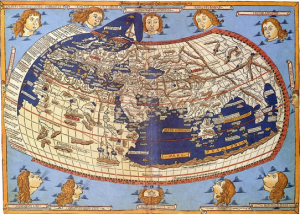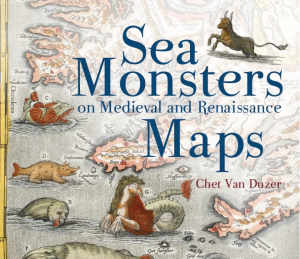 An Interview with Chet Van Duzer (Guest Contributor)
An Interview with Chet Van Duzer (Guest Contributor)
Wonders & Marvels: Can you tell us about your first experience in an archive?
Chet Van Duzer: One of my most memorable early experiences was consulting a 14th century nautical chart in the British Library. I had arrived in London from California the day before, and thus was jetlagged, but with the thrill of seeing that map up close and in person my fatigue vanished. The immediacy of my interaction with the document—not just the pleasure of appreciating the textures and colors, but also the satisfaction of being able to study the chart without wondering whether a problem with the reproduction or the digital image that was obscuring details—brought an excitement that I’ll never forget.
W&M: What sparked your interest in cartography?
 Van Duzer: I first became interested in maps during a visit to the Vatican Museums in 1997. I saw a manuscript of Ptolemy’s Geography from the mid 15th century on display. It was open to the folios immediately following the standard Ptolemaic world map, and on those folios a later artist had added a second world map in about 1530. At that time, which was long before the discovery of Antarctica or Australia, many geographers and cartographers believed that there was a continent in the far south, probably to balance the landmasses in the north, and on maps from that period one sometimes sees a continent, basically a big island, near the South Pole. This map on display in the Vatican Museums had a hypothetical southern continent, but in this case, rather than being a big island, it was huge ring of land around the South Pole. That really inspired my curiosity. Granted that one believed that there had to be land in the far south, how could one conclude that it was in the shape of a huge ring, with open water at the South Pole? So I started investigating, and that study drew me to devote more and more of my energy to old maps. I like the fact that they have curious features that seem at first glance to defy explanation; usually in fact there is a very good reason for those features, but one must find the explanation through research.
Van Duzer: I first became interested in maps during a visit to the Vatican Museums in 1997. I saw a manuscript of Ptolemy’s Geography from the mid 15th century on display. It was open to the folios immediately following the standard Ptolemaic world map, and on those folios a later artist had added a second world map in about 1530. At that time, which was long before the discovery of Antarctica or Australia, many geographers and cartographers believed that there was a continent in the far south, probably to balance the landmasses in the north, and on maps from that period one sometimes sees a continent, basically a big island, near the South Pole. This map on display in the Vatican Museums had a hypothetical southern continent, but in this case, rather than being a big island, it was huge ring of land around the South Pole. That really inspired my curiosity. Granted that one believed that there had to be land in the far south, how could one conclude that it was in the shape of a huge ring, with open water at the South Pole? So I started investigating, and that study drew me to devote more and more of my energy to old maps. I like the fact that they have curious features that seem at first glance to defy explanation; usually in fact there is a very good reason for those features, but one must find the explanation through research.
W&M: What is one research or writing related habit that is crucial to a good work-day?
Van Duzer: While working on one project, I always like to make at least some progress on future projects each day.
W&M: What advice do you have for beginning researchers entering libraries and archives?
Talk to colleagues who have worked in the archive before, and contact the relevant curator well in advance of your visit to ask about the most important documents you will be working on. Every archive has its bureaucratic frustrations and also its unique advantages, and advance knowledge of these can be extremely helpful. Contacting the curator ahead of time may seem superfluous, but it is better to be sure that the document you want to consult is not in conservation or away on exhibition, or to know that you need a special letter of recommendation in order to see it, than to discover these things only after arriving.
 Chet Van Duzer studied at UC Berkeley and has published extensively on medieval and Renaissance maps, particularly those of the fifteenth and sixteenth centuries. He is the author of Sea Monsters on Medieval and Renaissance Maps, which will be released in paperback this month.
Chet Van Duzer studied at UC Berkeley and has published extensively on medieval and Renaissance maps, particularly those of the fifteenth and sixteenth centuries. He is the author of Sea Monsters on Medieval and Renaissance Maps, which will be released in paperback this month.
